|
|
|
Sort Order |
|
|
|
Items / Page
|
|
|
|
|
|
|
| Srl | Item |
| 1 |
ID:
098654
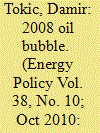

|
|
|
|
|
| Publication |
2010.
|
| Summary/Abstract |
We argue that "the 2008 Oil Bubble" was directly and indirectly created by the Federal Reserve in response to deflationary risks that resurfaced after the housing bubble burst and the resulting credit crisis of 2008. Deflationary risks first appeared after the dot.com bubble burst in 2000 and after the terrorist attacks on September 11, 2001. Manipulation of the US dollar value has been one of the key emergency tools in the Fed's arsenal. During the entire period from 2000 to 2008, the US dollar has been falling, while the price of crude oil has been rising, with the culmination in July 2008. If other global central banks embrace the Fed's anti-deflationary strategies, the consequences could be dire for the global economy, potentially resulting in an ultimate gold bubble.
|
|
|
|
|
|
|
|
|
|
|
|
|
|
|
|
| 2 |
ID:
098624
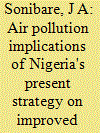

|
|
|
|
|
| Publication |
2010.
|
| Summary/Abstract |
One of the strategies being developed in Nigeria to increase the presently installed electricity generation of 6159 MW to the required 30,000 MW is the adoption of electric thermal plants. An emission factor approach is used in this paper to study the emission of uncontrolled air pollutants from all the existing and proposed thermal plants in the country. Calculations are performed to study the distribution of carbon monoxide (CO), oxides of nitrogen (NOX), particulate matters (PM), sulphur dioxide (SO2), and volatile organic compounds (VOCs). The estimated emissions ranges are 978-24,607, 1635-41,148, 37-924, 19-472, and 11-286 ton/annum for CO, NOX, PM, SO2, and VOCs, respectively. The present locations of these plants across the country are characterized by skewed emission distribution both per capita and across the land. Given the potential environmental and health impacts of these emissions, several measures are suggested to reduce future impacts and assist the country in achieving sustainable development.
|
|
|
|
|
|
|
|
|
|
|
|
|
|
|
|
| 3 |
ID:
098557
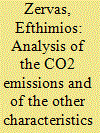

|
|
|
|
|
| Publication |
2010.
|
| Summary/Abstract |
Exhaust CO2 emitted from passenger cars is one of the major greenhouse effect gases. Several parameters influence the exhaust CO2 emissions of each passenger car: its characteristics (fuel used, vehicle weight, …) and its use (annual mileage, driving conditions, …). CO2 emissions from passenger cars decrease during last years; however, this decrease seems to reach its limits. Several parameters of the EU15 new PCs market, such as new passenger cars registrations, type of fuel used, engine capacity, max. power, max. specific power, segment distribution, vehicle weight and their CO2 emissions on the New European Driving Cycle are analyzed here. The target is to find the real market parameters influencing exhaust CO2 emissions. Because of the many data used and the parameters examined, this first part of the work is focused on the average values of each parameter studied and the values of each country, while the second part is based on the analysis of each PC segment and the third one on the analysis of the major brands presented in the European market.
|
|
|
|
|
|
|
|
|
|
|
|
|
|
|
|
| 4 |
ID:
098559
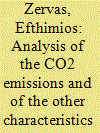

|
|
|
|
|
| Summary/Abstract |
This article analyzes the engine and vehicle characteristics and the CO2 emissions of the new passenger cars for all segments of the European market. As in the first article of this work, the target is to find the real market parameters influencing exhaust CO2 emissions. The present analysis is focused on the segment sales distribution (EU average and within each country) and also in four parameters of each segment influencing CO2 emissions: average vehicle weight, average engine capacity, average maximum and specific power. The second part of this work concerns the CO2 emissions of each segment on the New European Driving Cycle and its urban and extra urban parts.
|
|
|
|
|
|
|
|
|
|
|
|
|
|
|
|
| 5 |
ID:
098533


|
|
|
|
|
| Publication |
2010.
|
| Summary/Abstract |
Proton exchange membrane fuel cells (PEM FCs) offer a promising alternative to internal combustion engines in road transport. During the last decade PEM FC research, development and demonstration (RD&D) activities have been steadily increasing worldwide, and targets have been set to begin their commercialisation in road transport by 2015-2020. However, there still is considerable uncertainty on whether these targets will actually be met. The picture is complex and market and technology issues are closely interlinked; investment in RD&D projects is essential but not sufficient; the development of suitable early markets is also necessary and policy is set to play an important role. Auxiliary power units (APUs) are generally regarded as one important early market for FCs in transport. This paper analyses the possible future market for diesel PEM FC APUs onboard long-haul trucks and its implications for the development of PEM FCs in general. The analysis, part of the project HyTRAN (EC Contract no. 502577), is aided by the use of a dynamic simulation model of technology and markets developed by the author. Results suggest that an interesting window of opportunity for diesel PEM FC APUs exists but this is subject to additional research particularly targeted at the rapid development of fuel processors.
|
|
|
|
|
|
|
|
|
|
|
|
|
|
|
|
| 6 |
ID:
098631


|
|
|
|
|
| Publication |
2010.
|
| Summary/Abstract |
Support vector regression (SVR) had revealed strong potential in accurate electric load forecasting, particularly by employing effective evolutionary algorithms to determine suitable values of its three parameters. Based on previous research results, however, these employed evolutionary algorithms themselves have several drawbacks, such as converging prematurely, reaching slowly the global optimal solution, and trapping into a local optimum. This investigation presents an SVR-based electric load forecasting model that applied a novel algorithm, namely chaotic ant swarm optimization (CAS), to improve the forecasting performance by searching its suitable parameters combination. The proposed CAS combines with the chaotic behavior of single ant and self-organization behavior of ant colony in the foraging process to overcome premature local optimum. The empirical results indicate that the SVR model with CAS (SVRCAS) results in better forecasting performance than the other alternative methods, namely SVRCPSO (SVR with chaotic PSO), SVRCGA (SVR with chaotic GA), regression model, and ANN model.
|
|
|
|
|
|
|
|
|
|
|
|
|
|
|
|
| 7 |
ID:
098566


|
|
|
|
|
| Publication |
2010.
|
| Summary/Abstract |
This paper discusses the uptake potential for a wind-diesel production incentive designed specifically for Canadian northern and remote communities. In spite of having over 300 remote communities with extremely high electricity costs, Canada has had little success in developing remote wind energy projects. Most of Canada's large-scale wind power has been developed as a direct result of a Federal production incentive implemented in 2002. Using this incentive structure as a successful model, this paper explores how an incentive tailored to remote wind power could be deployed. Micro-power simulations were done to demonstrate that the production incentive designed by the Canadian Wind Energy Association would cost on average $4.7 $Cdn million and could be expected to result in 14.5 MW of wind energy projects in remote villages in Canada over a 10 year period, saving 11.5 $Cdn million dollars in diesel costs annually, displacing 7600 tonnes of CO2eq emissions and 9.6 million litres of diesel fuel every year.
|
|
|
|
|
|
|
|
|
|
|
|
|
|
|
|
| 8 |
ID:
098621


|
|
|
|
|
| Publication |
2010.
|
| Summary/Abstract |
The implementation of auctions of long-term electricity contracts is arising as an alternative to ensure generation investment and therefore achieve a reliable electricity supply. The aim is to reconcile generation adequacy with efficient energy purchase, correct risk allocation among investors and consumers, and the politico-economic environment of the country. In this paper, a generic proposal for a long-term electricity contracts approach is made, including practical design concepts for implementation. This proposal is empirically derived from the auctions implemented in Brazil and Chile during the last 6 years. The study is focused on practices and lessons which are especially useful for regulators and policy makers that want to facilitate the financing of new desirable power plants in risky environments and also efficiently allocate supply contracts among investors at competitive prices. Although this mechanism is generally seen as a significant improvement in market regulation, there are questions and concerns on auction performance that require careful design and which are identified in this paper. In addition, the experiences and proposal described can serve to derive further mechanisms in order to promote the entrance of particular generation technologies, e.g. renewables, in the developed world and therefore achieve a clean electricity supply.
|
|
|
|
|
|
|
|
|
|
|
|
|
|
|
|
| 9 |
ID:
098626


|
|
|
|
|
| Publication |
2010.
|
| Summary/Abstract |
Emissions of greenhouse gases in many European countries are declining, and the European Union (EU) believes it is on track in achieving emission reductions as agreed upon in the Kyoto Agreement and the EU's more ambitious post-Kyoto climate policy. However, a number of recent publications indicate that emission reductions may also have been achieved because production has been shifted to other countries, and in particular China. If a consumption perspective is applied, emissions in industrialized countries are substantially higher, and may not have declined at all. Significantly, emissions from transports are omitted in consumption-based calculations. As all trade involves transport, mostly by cargo ship, but also by air, transports add considerably to overall emissions growth incurred in production shifts. Consequently, this article studies the role of transports in creating emissions of CO2, based on the example of exports from China. Results are discussed with regard to their implications for global emission reductions and post-Kyoto negotiations.
|
|
|
|
|
|
|
|
|
|
|
|
|
|
|
|
| 10 |
ID:
098623
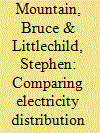

|
|
|
|
|
| Publication |
2010.
|
| Summary/Abstract |
A decade ago, electricity distribution network revenues per customer in New South Wales (NSW) were twice those in Great Britain (GB). Recent price controls imply that by 2014 they will be nearly four times as high. This paper examines possible reasons for this. The main reason does not seem to be geography, operating environment or industry structure. GB and Victoria have managed to accommodate increasing demand at broadly constant or even declining costs and revenues while delivering higher quality of service, while NSW has not. The regulatory framework and the practice of the regulatory body within that framework seem relevant. Australian regulators have not used benchmarking techniques as the GB regulator has. Perhaps the most important explanatory factor is private ownership in GB and Victoria compared to state ownership in NSW. This could also impact on the nature and effectiveness of regulation.
|
|
|
|
|
|
|
|
|
|
|
|
|
|
|
|
| 11 |
ID:
098569


|
|
|
|
|
| Publication |
2010.
|
| Summary/Abstract |
We evaluated several variants of a variable biofuel subsidy and compared them with the fixed subsidy and Renewable Fuel Standard using two different modeling approaches. First we used a partial equilibrium model encompassing crude oil, gasoline, ethanol, corn, and ethanol by-products. Second, we used a stochastic simulation model of a prototypical ethanol plant. From the partial equilibrium analysis, it appears the variable subsidy provides a safety net for ethanol producers when oil prices are low; yet, it does not put undue pressure on corn prices when oil prices are high. At high oil prices, the level of ethanol production is driven by market forces. From the plant level stochastic analysis, essentially the same conclusions are reached. As with the fixed subsidy, the variable subsidy can increase the net present value (NPV) sufficiently to encourage investment, but with lower risk for the producer, lower probability of a loss from the investment, and often lower expected cost to government. Finally, in the US, the ethanol industry is up against a blending limit called the blend wall. If the blending wall remains in place and no way around it is found, it does not matter much what other policy options are used.
|
|
|
|
|
|
|
|
|
|
|
|
|
|
|
|
| 12 |
ID:
098618


|
|
|
|
|
| Publication |
2010.
|
| Summary/Abstract |
Today's society relies heavily on fossil fuels as a main energy source. Global energy demand increase, energy security and climate change are the main drivers of the transition towards alternative energy sources. This paper analyses algal biodiesel production for the EU road transportation and compares it to the fossil fuels and 1st generation biofuels. A cost-effectiveness analysis was used to aggregate private and external costs and derive the social cost of each fuel. The following externalities were internalized: emissions (GHG and non-GHG), food prices impact, pesticides/fertilizers use and security of supply. Currently the social cost of producing algal biodiesel at 52.3 € GJ-1 is higher than rapeseed biodiesel (36.0 € GJ-1) and fossil fuels (15.8 € GJ-1). Biotechnology development, high crude oil prices and high carbon value are the key features of the scenario where algal biodiesel outcompetes all other fuels. A substantial investment into the biotechnology sector and comprehensive environmental research and policy are required to make that scenario a reality.
|
|
|
|
|
|
|
|
|
|
|
|
|
|
|
|
| 13 |
ID:
098630


|
|
|
|
|
| Publication |
2010.
|
| Summary/Abstract |
The fact that depletion of indigenous gas production increases gas import dependency is widely known and accepted. However, there is considerable less attention for the implications of indigenous resource depletion for the provision of seasonal flexibility. The traditionally largest source of seasonal flexibility in Europe is indigenous gas production, mainly based in the Netherlands and the United Kingdom. With the depletion of indigenous sources the market increasingly needs to rely on other sources for seasonal flexibility, such as gas storage facilities. We investigate the future need for gas storage as a source for seasonal flexibility provision using a dynamic gas market model (GASTALE) in which different potential sources for seasonal flexibility - gas production, imports via pipeline, LNG imports and storage facilities - compete with each other in a market-based environment. The inclusion of seasonal flexibility properties in a gas market model allows a more complex analysis of seasonal flexibility issues than previously documented in literature. This is demonstrated in an analysis of the future demand for gas storage in northwestern Europe until 2030. Our results indicate that there is substantial need for additional gas storage facilities and thus supports current project proposals for new investment in gas storage facilities.
|
|
|
|
|
|
|
|
|
|
|
|
|
|
|
|
| 14 |
ID:
098610


|
|
|
|
|
| Publication |
2010.
|
| Summary/Abstract |
Improving access to affordable modern energy is critical to improving living standards in the developing world. Rural households in India, in particular, are almost entirely reliant on traditional biomass for their basic cooking energy needs. This has adverse effects on their health and productivity, and also causes environmental degradation. This study presents a new generic modelling approach, with a focus on cooking fuel choices, and explores response strategies for energy poverty eradication in India. The modelling approach analyzes the determinants of fuel consumption choices for heterogeneous household groups, incorporating the effect of income distributions and traditionally more intangible factors such as preferences and private discount rates. The methodology is used to develop alternate future scenarios that explore how different policy mechanisms such as fuel subsidies and micro-financing can enhance the diffusion of modern, more efficient, energy sources in India.
|
|
|
|
|
|
|
|
|
|
|
|
|
|
|
|
| 15 |
ID:
098656


|
|
|
|
|
| Publication |
2010.
|
| Summary/Abstract |
This study models the costs of electricity generation with carbon capture and sequestration (CCS), from generation at the power plant to carbon injection at the reservoir, examining the economic factors that affect technology choice and CCS costs at the individual plant level. The results suggest that natural gas and coal prices have profound impacts on the carbon price needed to induce CCS. To extend previous analyses we develop a "cost region" graph that models technology choice as a function of carbon and fuel prices. Generally, the least-cost technology at low carbon prices is pulverized coal, while intermediate carbon prices favor natural gas technologies and high carbon prices favor coal gasification with capture. However, the specific carbon prices at which these transitions occur is largely determined by the price of natural gas. For instance, the CCS-justifying carbon price ranges from $27/t CO2 at high natural gas prices to $54/t CO2 at low natural gas prices. This result has important implications for potential climate change legislation. The capital costs of the generation and CO2 capture plant are also highly important, while pipeline distance and criteria pollutant control are less significant.
|
|
|
|
|
|
|
|
|
|
|
|
|
|
|
|
| 16 |
ID:
098642
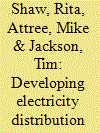

|
|
|
|
|
| Publication |
2010.
|
| Summary/Abstract |
A more sustainable energy system will alter the current patterns of electricity demand and generation. This means technical, commercial and regulatory change for electricity network systems such as distribution networks. This paper traces the links in Great Britain between changes in energy policy since privatisation, changes in the objectives of the electricity regulator and changes in the objectives of the distribution networks and their owners, the distribution network operators (DNOs). The paper identifies tensions in regulatory policy and suggests reforms to the regulatory framework to support a lower-carbon future.
DNOs are licensed regional infrastructure providers. In addition to their network services, the network companies can potentially deliver public policy objectives to facilitate heat infrastructure, energy-efficiency and distributed renewables. The paper identifies the potential benefits of a novel approach to facilitating renewable energy feed-in tariffs for electricity and heat, using DNOs.
|
|
|
|
|
|
|
|
|
|
|
|
|
|
|
|
| 17 |
ID:
098563


|
|
|
|
|
| Publication |
2010.
|
| Summary/Abstract |
In this second paper, which studies the hourly generation data from the Israel Electric Corporation for the year 2006, with a view to adding very large-scale photovoltaic power (VLS-PV) plants, three major extensions are made to the results reported in our first paper. In the first extension, PV system simulations are extended to include the cases of 1- and 2-axis sun-tracking, and 2-axis concentrator photovoltaic (CPV) technologies. Secondly, the effect of distributing VLS-PV plants among 8 Negev locations, for which hourly metrological data exist, is studied. Thirdly, in addition to studying the effect of VLS-PV on grid penetration, the present paper studies its effect on grid ramping requirements. The principal results are as follows: (i) sun-tracking improves grid matching at high but not low levels of grid flexibility; (ii) geographical distribution has little effect on grid penetration; (iii) VLS-PV significantly increases grid ramping requirements, particularly for CPV systems, but not beyond existing ramping capabilities; (iv) geographical distribution considerably ameliorates this effect.
|
|
|
|
|
|
|
|
|
|
|
|
|
|
|
|
| 18 |
ID:
098632


|
|
|
|
|
| Publication |
2010.
|
| Summary/Abstract |
The Energy Performance Building Directive (Directive 2002/91/EC) introduced the compulsory energy certification of buildings in the EU from 2006 and it has played a key role in the common policy to monitor and reduce energy consumption. In order to assess the experience gained in this field in Europe overall, and in particular against the highly diverse settings of the different European nations, this paper examines the extent to which the Directive has been implemented by the 27 EU Member States. This is done via a comparative analysis assisted by two different indicators: of uniformity and of excellence. The measure of uniformity makes it possible to assess the degree of harmony of the individual Member States with regard to the parameters laid down by the European Commission, while the measure of excellence allows the Member States to be appraised and the "best" performers to be identified, i.e. the leaders as regards energy certification of buildings. The analysis conducted reveals how varied the situation regarding energy certification in each country is in terms of implementation and scope of application and it also reveals that most countries are still at a halfway stage towards achieving excellence.
|
|
|
|
|
|
|
|
|
|
|
|
|
|
|
|
| 19 |
ID:
098562


|
|
|
|
|
| Publication |
2010.
|
| Summary/Abstract |
We present the results of a number of PV-grid matching simulations performed using hourly generation data from the Israel Electric Corporation (IEC) for the year 2006, together with corresponding meteorological data from Sede Boqer in the Negev Desert. The principal results of this investigation are: (1) the effective flexibility factor (ff) of the IEC grid was close to ff=0.65, but with a different plant operating strategy, ff could have been considerably higher; (2) for ff=0.65, the largest no-dump PV system could have provided only 2.7% of the annual demand, but for higher flexibilities - up to ff=1 - the percentage penetration could be as high as 17.4%; (3) considerable improvement in penetration can result by relaxing the "no-dump" criterion initially imposed on the PV system; (4) using the IEC's existing plant types, additional penetration can be expected by re-scheduling part of the base-load generating capacity to anticipate expected solar input; (5) for a radically decreased grid flexibility - that might result from IEC decisions about future generator purchases - the required employment of massive amounts of storage would render the potential contribution of PV to be insignificant.
|
|
|
|
|
|
|
|
|
|
|
|
|
|
|
|
| 20 |
ID:
098561


|
|
|
|
|
| Summary/Abstract |
We present the results of a number of PV-grid matching simulations performed using hourly generation data from the Israel Electric Corporation (IEC) for the year 2006, together with corresponding meteorological data from Sede Boqer in the Negev Desert. The principal results of this investigation are: (1) the effective flexibility factor (ff) of the IEC grid was close to ff=0.65, but with a different plant operating strategy, ff could have been considerably higher; (2) for ff=0.65, the largest no-dump PV system could have provided only 2.7% of the annual demand, but for higher flexibilities - up to ff=1 - the percentage penetration could be as high as 17.4%; (3) considerable improvement in penetration can result by relaxing the "no-dump" criterion initially imposed on the PV system; (4) using the IEC's existing plant types, additional penetration can be expected by re-scheduling part of the base-load generating capacity to anticipate expected solar input; (5) for a radically decreased grid flexibility - that might result from IEC decisions about future generator purchases - the required employment of massive amounts of storage would render the potential contribution of PV to be insignificant.
|
|
|
|
|
|
|
|
|
|
|
|
|
|
|
|
|
|
|
|
|